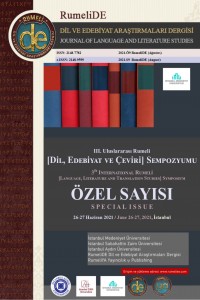Öz
Kurban ritüeli olarak bilinen Tauroctony, Jung’un psikolojik yaklaşımında öne sürdüğü anima-mundi başka bir deyişle, yaşam enerjisinin (libido-thanatos) bir dışa vurumu olarak kabul edilebilir. Bu kültün sembolik önemi, evrenin ruhunun doğal akışında yaşamın bütünlüğünü görmek adına önem arz eder. Artaud, “The Theater and Its Double” adlı eserinde Batı medeniyetinin doğayla organik bağlarını koparması ve kendini baskın dilin totaliter ilkelerinin yörüngesindeki aşınmış kurumlarıyla zehirlemiş olmasından dolayı Batı toplumunda çok uzun zamandır organik enerjinin doğal seyrinin önü kesilmiş olduğunu belirtir. Artaud, dilin enfekte olmasından dolayı kontrolden çıkmış bir salgının Avrupa’yı çok sert vurduğunu ileri sürer. Buna rağmen, ilginçtir ki, Artaud salgına karşı olumlu bir tutum sergiler. O, toplumdaki çürümüş organları eritecek olan salgının yıkıcı gücündeki yaratıcı potansiyeli görür. Bu yaratıcı güç sayesinde, çürümüş yapılarından arınmış olan toplum orijinal döngüsüne geri dönecektir. Artaud, salgının kendini en iyi gösterdiği yerin tiyatro olduğunu haklı olarak öne sürer. Dilin aşındırıcı etkisi, en iyi Batı tiyatrosunda gözlemlenir. Artaud, bu salgın havasını toplumu yeniden ritüelliktik köklerine bağlamak için bir fırsat olarak görür. Bunun için, Batı toplumunun enfekte olmuş vücudunu arındırmak için “Şiddet Tiyatrosu” adında yeni bir tiyatro akımı başlatır. Bu bağlamda, bu çalışma, Artaud’un “Cenci” adlı meşhur eseri üzerine detaylı bir araştırma yaparak Şiddet Tiyatrosu’nun arındırıcı misyonunu keşfetmeyi amaçlar.
Anahtar Kelimeler
Kaynakça
- Artaud, Antonin. (1970). The Cenci. Grove Press, Inc., New York, First Evergreen Edition.
- Artaud, Antonin. (1958). The Theater and Its Double. Grove Press 841 Broadway New York, NY 10003. Blin, R., Artaud, A., Kirby, V. N., Nes, N. E., & Robbins, A. (1972). Antonin Artaud in" Les Cenci". The Drama Review: TDR, 91-145.
- Clancy, P. (1985). Artaud and the Balinese theatre. Modern drama, 28(3), 397-412.
- Curtin, A. (2010). Cruel Vibrations: Sounding Out Antonin Artaud's Production of Les Cenci1. Theatre Research International, 35(3), 250-262.
- DK. (2018). The Mythology Book: Big Ideas Simply Explained.
- Ferenczi, S. (1995). The clinical diary of Sándor Ferenczi. Harvard University Press.
- Forbes, A. (2015). Return of the Cenci: Theaters of Trauma in Shelley and Artaud. Comparative Literature, 67(4), 394-414.
- Goodall, J. (1987). Artaud's revision of Shelley's The Cenci: the text and its double. Comparative drama, 21(2), 115-126.
- Murphy, J. (2016). Artaud's Metamorphosis: From Hieroglyphs to Bodies Without Organs. Pavement Books.
- Palermo, C. (2007). Towards the embodiment of the mask Balinese topeng in contemporary practice (Doctoral dissertation, University of Tasmania).
- Vork, R. (2013). Things that no one can say: The unspeakable act in Artaud’s Les Cenci. Modern Drama, 56(3), 306-326.
Öz
The Tauroctony, commonly known as the bull-slaying cult can be regarded as the manifestation of the anima mundi, or the life-giving and taking energy (libido-thanatos) in the Jungian psychology. The symbolical significance of this cult is essential to see the totality of life in the natural circulation of the anima mundi. Artaud in Theatre and Its Double argues that the natural cycle of the unbridled energy has long been disrupted in the Western society since the Western civilization has cut the organic ties with the nature and has infected itself with the worn-out institutions in the grip of the poisonous, hegemonic language with its totalizing principles. He asserts that an uncontrollable plague has struck Europe due to the infection in the language. However, interestingly enough, he takes a positive stance towards the uncontrollable plague. He sees the potential procreation in the destructive power of this plague that would eventually melt the decomposed organs in the society. Thanks to this, the flattened body of the society cleansed of the rotten institutions will cure itself back to its original cycle. Artaud justifiably asserts that the plague best manifests itself in its double: In theatre. The corrosive effect of the language is best observed in the Western theatre. Artaud sees the plague as an opportunity to restore it back to its ritual roots. He develops a new form of theatre, “the Theatre of Cruelty” to cleanse the infected body of the Western society. In this context, this study aims to explore the cleansing mission of Artaud’s Theatre of Cruelty by corroborating the discussion with a detailed study on his notable play, Cenci.
Kaynakça
- Artaud, Antonin. (1970). The Cenci. Grove Press, Inc., New York, First Evergreen Edition.
- Artaud, Antonin. (1958). The Theater and Its Double. Grove Press 841 Broadway New York, NY 10003. Blin, R., Artaud, A., Kirby, V. N., Nes, N. E., & Robbins, A. (1972). Antonin Artaud in" Les Cenci". The Drama Review: TDR, 91-145.
- Clancy, P. (1985). Artaud and the Balinese theatre. Modern drama, 28(3), 397-412.
- Curtin, A. (2010). Cruel Vibrations: Sounding Out Antonin Artaud's Production of Les Cenci1. Theatre Research International, 35(3), 250-262.
- DK. (2018). The Mythology Book: Big Ideas Simply Explained.
- Ferenczi, S. (1995). The clinical diary of Sándor Ferenczi. Harvard University Press.
- Forbes, A. (2015). Return of the Cenci: Theaters of Trauma in Shelley and Artaud. Comparative Literature, 67(4), 394-414.
- Goodall, J. (1987). Artaud's revision of Shelley's The Cenci: the text and its double. Comparative drama, 21(2), 115-126.
- Murphy, J. (2016). Artaud's Metamorphosis: From Hieroglyphs to Bodies Without Organs. Pavement Books.
- Palermo, C. (2007). Towards the embodiment of the mask Balinese topeng in contemporary practice (Doctoral dissertation, University of Tasmania).
- Vork, R. (2013). Things that no one can say: The unspeakable act in Artaud’s Les Cenci. Modern Drama, 56(3), 306-326.
Ayrıntılar
| Birincil Dil | İngilizce |
|---|---|
| Konular | Dilbilim |
| Bölüm | Dünya dilleri, kültürleri ve edebiyatları |
| Yazarlar | |
| Yayımlanma Tarihi | 21 Ağustos 2021 |
| Yayımlandığı Sayı | Yıl 2021 Sayı: Ö9 |


